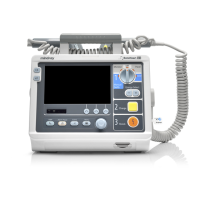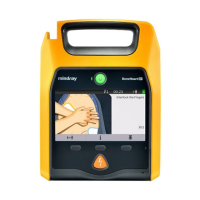14 - 2
• Change the application site or replace the sensor and/or patient cable when a persistent “SpO2 Low
Signal Quality” message is displayed on the equipment. These messages may indicate that patient
monitoring time is exhausted on the patient cable or sensor.
• Replace the cable or sensor when a “SpO2 Sensor Off”, “SpO2 No Sensor”, or “SpO2 Low Signal
Quality” message is consistently displayed while monitoring consecutive patients after completing
troubleshooting steps listed in this manual.
• Variation in measurements may be profound and may be affected by sampling technique as well as
the patient's physiological conditions. Any results exhibiting inconsistency with the patient’s clinical
status should be repeated and/or supplemented with additional test data. Blood samples should be
analyzed by laboratory instruments prior to clinical decision making to completely understand the
patient’s condition.
• Do not place the pulse oximeter where the controls can be changed by the patient.
• If using pulse oximetry during full body irradiation, keep the sensor out of the radiation field. If the
sensor is exposed to the radiation, the reading might be inaccurate or the device might read zero for
the duration of the active irradiation period.
• Additional information specific to the Masimo sensors compatible with the equipment, including
information about parameter/measurement performance during motion and low perfusion, may be
found in the sensor's directions for use (DFU).
• Masimo cables and sensors are provided with X-Cal™ technology to minimize the risk of inaccurate
readings and unanticipated loss of patient monitoring. Refer to the Cable or Sensor DFU for the
specified duration of the patient monitoring time.
14.3 SpO
2
Display
• PI is only available for Mindray SpO
2
and Masimo SpO
2
.
14.4 Preparing for SpO
2
Monitoring
• Select proper SpO2 sensor according to application site. Applying sensor too tight may severely
obstruct circulation and lead inaccurate measurements. Loose application may result in
measurement site exposing to ambient light.
• Avoid placing the SpO
2
sensor on the same extremity with an NIBP cuff, arterial catheter, or
intravascular line.
• When monitoring SpO
2
at high ambient temperature, to avoid burns at the application site that is
not well perfused, pay attention to prolonged SpO
2
sensor application.
14.5 Changing SpO
2
Settings
14.5.1 Changing the SpO
2
Alarm Properties
• You can switch off the SpO2 Desat alarm only when SpO2 Desat Alarm Off is enabled. For more
information, see section 10.2.2Setting the Switch of SpO
2 Desat Alarm Off
.

